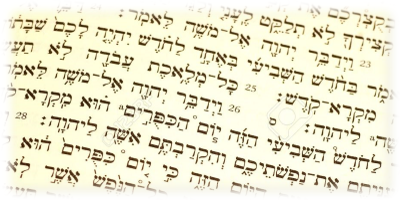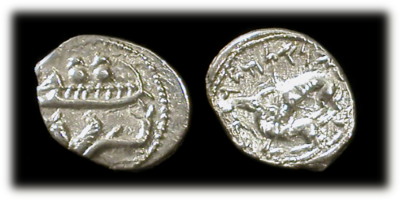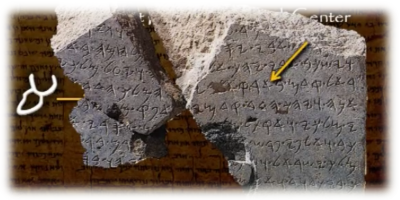The Ayin and Ghayin
While the Modern Hebrew alphabet consists of twenty-two letters, the evidence suggests that there were additional letters in the original Semitic and Hebrew alphabet. One of the ancient Semitic languages of Canaan was Ugarit. This ancient language is almost identical to the Hebrew language of the Bible but, instead of consisting of twenty-two letters it has twenty-eight letters. One of the major differences between Ugarit and Hebrew is the additional letter ghayin ( ), which does not exist in Hebrew. Evidence, such as will be presented here, suggest that the letter "ghayin" did originally exist within the Hebrew text of the Bible, but at some point, in the ancient past, the letter ghayin began to be written with the letter ayin (
), which does not exist in Hebrew. Evidence, such as will be presented here, suggest that the letter "ghayin" did originally exist within the Hebrew text of the Bible, but at some point, in the ancient past, the letter ghayin began to be written with the letter ayin ( , ע in the modern Hebrew).
, ע in the modern Hebrew).
One Word - Two Meanings
The strongest evidence for the missing ghayin can be found in the two different meanings of one Hebrew word. As an example, the Hebrew word רע (ra) can mean "friend" or "bad". In the ancient past, the Hebrew word 
 , written as רע in the modern Hebrew alphabet and identified in Strong's Dictionary as #7453, meant "friend" and the Hebrew word
, written as רע in the modern Hebrew alphabet and identified in Strong's Dictionary as #7453, meant "friend" and the Hebrew word 
 , also written as רע in the modern Hebrew alphabet and identified in Strong's Dictionary as #7451, meant "bad." Below are a few other examples of Hebrew words that are spelled with an ayin that have more than one meaning.
, also written as רע in the modern Hebrew alphabet and identified in Strong's Dictionary as #7451, meant "bad." Below are a few other examples of Hebrew words that are spelled with an ayin that have more than one meaning.
| Hebrew | Ayin | Ghayin |
|---|---|---|
| עול | infant (#5764) | wicked (#5766) |
| יעל | profit (#3276) | goat (#3277) |
| ענה | heed (#6030) | afflict (#6031) |
| עיף | weary (#5888) | darkness (#5890) |
| עור | skin (#5785) | blind (#5786) |
| עיר | colt (#5895) | city (#5892) |
| שער | hair (#8163) | storm (#8175) |
| ערב | weave (#6148) | dark (#6150) |
| ערום | naked (#6174) | crafty (#6175) |
| ערף | neck (#6202) | drop (#6201) |
While one word with two meanings may not seem strange to us as the English language is filled with words with more than one meaning, this is a very rare occurrence in Hebrew and when it does occur, it suggests that they were originally two different words.
If in fact the letter ayin represents two ancient letters, how can we determine which letter was originally used in a given word. As an example, was the ayin in the Hebrew word סעה (Strong's #5584) originally spelled with an ayin or a ghayin? When we compare the meanings of the words in the table above, you will notice that the words in the far-right column are all related to darkness (dark, storm, clouds, rain, blind) and wickedness (wicked, goat, city, bad, crafty). As the Hebrew word סעה means "storm," which is related to the idea of "darkness," we can conclude that it was originally spelled with a ghayin. below are a few other words that were most likely originally written with a ghayin.
| עב | cloud | |
| עוב | cloud | |
| עוה | perverse, crooked | |
| עות | crooked | |
| עז | goat | |
| עקל | crooked | |
| עקש | crooked |
Modern and Historical evidence of letter changes
This shift from the ghayin to the ayin is not unique with ancient, and even modern words. Over time words and their roots evolve. To demonstrate this, let us look at an English word and its evolution. The words, "napkin" and "apron" are derived from the word "map". In ancient times maps were written on sheets of fabric called "maps". A very common shift in letters as words evolve is from an "m" to an "n" and vice versa. The word "napkin", a sheet of fabric, is the word "map" with the suffix "kin" added to it. An old English word "napron", also a sheet of fabric tied around the body, is the word "map" (with a shift from an "m" to an "n") with the suffix "ron" added to it. As we would refer to this latter word as "a" napron, the "n" shifted to the "a" and became "an" "apron"."
This same shift of letters can be seen many times in the evolution of Hebrew words. Within the Biblical text we have the ancient parent root זב (zav) meaning "yellow". From this parent root are derived two child roots, זהב (zahav, Strong's #2091) meaning "gold" and זוב (zuv, Strong's #2101) meaning "pus", both being yellow in color. Another Hebrew word, צהב (tsahav, Strong's #6669), also has the meaning "yellow," but has no connection to the ancient parent root צב (tsav, Strong's #6632) meaning a "wall". From this evidence, we can conclude that צהב is an evolved form of the root זהב, as the צ (ts) and ז (z) sounds are very similar."
The idea of the letter ghayin shifting to the ayin is not unique in the Hebrew vocabulary, in fact it is quite common, except that in this case, every use of the ghayin shifted over to the ayin.
Greek Transliterations of the ghayin
Additional evidence to the existence of the letter ghayin is the Greek transliteration of Hebrew names. When the Hebrew Bible was translated into Greek about 2,000 years ago, the translator transliterated the Hebrew names into Greek. An example of transliterating a name into another language can be seen in the Hebrew name אדם, which is transliterated into the Roman letters as "Adam."
When we examine Hebrew names that contain the Hebrew letter ayin, we find two different methods of transliterating the letter. Table 1 below contains Hebrew names where the ayin is not transliterated (the Hebrew letter ayin is silent and is represented by an apostrophe in the English transliateration). Table 2 contains Hebrew names where the ayin is transliterated with the Greek letter Gamma (Γ or γ).
| Hebrew | Greek | English | ||
|---|---|---|---|---|
| בעל (ba‘al) | Βααλ (Baal) | Ba‘al | ||
| בלעם (bil‘am) | Βαλααμ (Balaam) | Bala‘am | ||
| עשתרות (‘ashtarot) | Ασταρωθ (Astaroth) | ‘Ashtaroth |
| Hebrew | Greek | English | ||
|---|---|---|---|---|
| עמרה ('amorah) | Γομορραν (gomorras) | Gomorrah | ||
| עזה ('azzah) | Γαζαν (gazan) | Gaza | ||
| פעור (pe'or) | Φογορ (pogor) | Peor |
Only Hebrew is missing the ghayin
Arabic, another modern Semitic language, has managed to retain both the ayin and ghayin as separate letters. The Arabic letter  represents the ayin, while the
represents the ayin, while the  represents the ghayin. The ancient Ugarit language also makes a distinction between the ayin, written as
represents the ghayin. The ancient Ugarit language also makes a distinction between the ayin, written as  , and the ghayin, written as
, and the ghayin, written as  .
.
Edward Horowitz
The following is an excerpt from Edward Horowitz's book How the Hebrew Language Grew, by KTAV publishing.
Ancient Hebrew had two different ע sounds. These sounds were represented in our alphabet by the letter ע. One was a harsh, heavy ע. This is now lost, and no longer used in Hebrew. The other was a soft, mild ע. When the Greek Jews translated the Bible into Greek, they had to transliterate Hebrew names having the harsh ע in it. They used the Greek letter gamma for it - so you can just imagine how hard a sound it must have been. This "ע gayin" has even come all the way down to English. The Hebrew place names עמרה and עזה both of which have this strong ע were transliterated into Greek as Gommora and Gaza. Didn't the odd forms of these place names in English ever puzzle you? In medieval times there was exported from Gaza a thin fabric which was naturally name "gauze" after the city of its origin."
Incidentally, Arabic a close sister language of Hebrew, still pronounces these two ע's differently, and what's more writes them differently.
This simple piece of knowledge about the existence of two different ע's, should clear up a great many puzzling different meanings that you will often find in a root that has an ע in it.
What does all this mean to the study of the Hebrew language?
In the study of the ancient Hebrew language and alphabet we begin studying the language at its simplest roots, the letters. Each letter is a picture that represents a meaning. When the letters are combined to form roots, each letter supplies meaning to the root. By then studying the various words, which are derived out of any given root, we can begin to reconstruct the original root language of Hebrew. In order to be as accurate as possible, we need to be sure that we are using the correct words, roots and letters."
Now that the twenty-third letter of the Hebrew alphabet has been found, are there others? The answer is most likely "yes." Edward Horowitz claims that there are two חs, two שs, two זs and three צs bringing the total count of Hebrew letters to twenty-eight. Interestingly the Arabic alphabet contains twenty-eight letters and the ancient Ugarit alphabet contains thirty, but this includes two variations of the letter aleph, bringing us back to twenty-eight letters.
The Shin, Sin and Samehh
In the Modern Hebrew alphabet the letter shin (ש) represents two different sounds, a "sh" and an "s". To differentiate between these two sounds, a dot is placed above the shin in different locations. For the "sh" sound, the dot is placed on the right (שׁ) and is called a shin and for the "s" sound it is placed on the left (שׂ) and called a sin.
In most cases words spelled with the sin are more closely related in meaning with words spelled with the samech (ס). In addition, Hebrew words spelled with the sin are written with the samech in other Semitic languages. As an example, in the Masoretic text you will find the name ישׂראל (yisra'el/Israel), but this name was most likely originally spelled as יסראל, which interestingly is the spelling of this name in the Aramaic translations of the Old Testament. In the Hebrew Bible, several Hebrew words written with the שׂ are also written with a ס as is demonstrated in the table below.
| נשׂא | נסא | nasa | Lift up | |||
| שׂור | סור | sur | Remove | |||
| שׂכך | סכך | sakak | Cover | |||
| שׂוט | סוט | sut | Turn aside | |||
| שׂט | סט | set | Rebel | |||
| ששׂה | שסה | shasah | Plunder |
The Vav and Yud
Until 1947, the oldest manuscript of the Hebrew Bible was the Codex Leningrad which is dated to around 1,000 A.D. With the discovery of the Dead Sea Scrolls in 1947 we now have manuscripts that are 1000 years older than the Codex Leningrad. While the Hebrew texts from the Dead Sea Scrolls (2000 years old) and the Hebrew text from the Codex Leningrad (1000 years old) are very similar, there are differences. One of the largest differences is the vowels used for the text. Throughout the Codex Leningrad, vowel sounds are represented by dots and dashes placed above and below the letters. For instance, the Hebrew word for 'no', as it appears in the codex, is לֹא (lo, Strong's #3808). The dot above the letter aleph is called a hholam and represents the vowel sound 'o'. These dots and dashes (called nikkudot, nikkud in the singular) were created by the Masorites during the time the codex Leningrad was written. The Dead Sea Scrolls, written long before the Masorites, used the letter ו (waw, vav in Modern Hebrew) for the consonant 'w,' but also for the vowel sound 'o'. Throughout the Dead Sea Scrolls, this word appears as לוא. In the Masoretic text the name David is written as דָוִד (dawid). The dot, called the hhireq, below the ו represents the 'i' sound. However, in the Dead Sea Scrolls the name David is written as דויד where the letter י (yud) is used for the 'i' sound.
From the vast number of manuscripts unearthed in the Dead Sea Caves it has been discovered that the letters waw and yud (and to a lesser extent the letters hey and aleph) were widely used as vowels. When and why, they were removed from the text and replaced with the nikkudot appears to be a mystery.

Like what you’re discovering? Continue the journey from Bible reader to translator.
|






